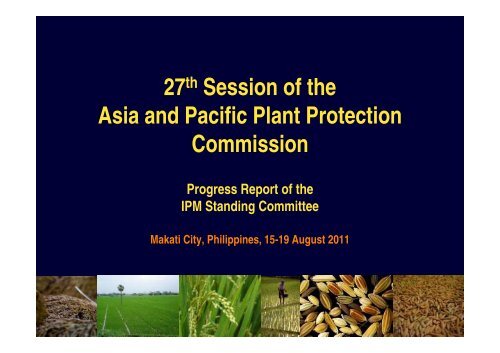Progress Report of the Standing Committee on Integrated Pest ...
Progress Report of the Standing Committee on Integrated Pest ...
Progress Report of the Standing Committee on Integrated Pest ...
- No tags were found...
You also want an ePaper? Increase the reach of your titles
YUMPU automatically turns print PDFs into web optimized ePapers that Google loves.
27 th Sessi<strong>on</strong> <str<strong>on</strong>g>of</str<strong>on</strong>g> <str<strong>on</strong>g>the</str<strong>on</strong>g>Asia and Pacific Plant Protecti<strong>on</strong>Commissi<strong>on</strong>i<str<strong>on</strong>g>Progress</str<strong>on</strong>g> <str<strong>on</strong>g>Report</str<strong>on</strong>g> <str<strong>on</strong>g>of</str<strong>on</strong>g> <str<strong>on</strong>g>the</str<strong>on</strong>g>IPM <str<strong>on</strong>g>Standing</str<strong>on</strong>g> <str<strong>on</strong>g>Committee</str<strong>on</strong>g>Makati City, Philippines, 15-19 August 2011
Crop producti<strong>on</strong> intensificati<strong>on</strong> strategies <str<strong>on</strong>g>of</str<strong>on</strong>g>nati<strong>on</strong>al food security agenda have resulted inhigher incidences <str<strong>on</strong>g>of</str<strong>on</strong>g> plant pests and diseasesin am<strong>on</strong>g APPPC member countries.High cropping intensities, indiscriminateg pp g ,pesticide usage, fertilizer overuse have causedsevere BPH outbreaks in Ind<strong>on</strong>esia, Thailand,Vietnam and China.
<strong>Pest</strong> and disease problems have been exacerbatedby <str<strong>on</strong>g>the</str<strong>on</strong>g> entry <str<strong>on</strong>g>of</str<strong>on</strong>g> invasive plant pests and diseasesresulting from food & plant trade as well as byemerging pests and diseases resulting fromclimate change.Corn Planthopper; Coc<strong>on</strong>ut Hispine Beetle;pp ; p ;Golden Apple Snails; Rodents; Cassava PinkMealybug; Phytoplasma Diseases in Sugarcane
On-going IPM Programs and Activitiesin Asia and Pacific Development <str<strong>on</strong>g>of</str<strong>on</strong>g> ecological-based, envir<strong>on</strong>mentalfriendlytechnologies and mechanisms for <str<strong>on</strong>g>the</str<strong>on</strong>g>preventi<strong>on</strong> and c<strong>on</strong>trol <str<strong>on</strong>g>of</str<strong>on</strong>g> plant pests and diseases; Quality farmer educati<strong>on</strong> to ensure <str<strong>on</strong>g>the</str<strong>on</strong>g> adopti<strong>on</strong> <str<strong>on</strong>g>of</str<strong>on</strong>g>preventive and c<strong>on</strong>trol technologies & mechanisms.
Collaborative IPM Programs andActivities in Asia and Pacific APPPC Member Countries’ IPMInitiatives FAO Initiatives in IPM IRRI Initiatives in IPM IPM CRSP Initiatives
IPM Initiatives <str<strong>on</strong>g>of</str<strong>on</strong>g> APPPC Member CountriesCHINAInstituti<strong>on</strong>alizati<strong>on</strong> and nati<strong>on</strong>widescaling-up <str<strong>on</strong>g>of</str<strong>on</strong>g> FFS-based extensi<strong>on</strong>and farmer educati<strong>on</strong>.NEPAL:C<strong>on</strong>duct <str<strong>on</strong>g>of</str<strong>on</strong>g> IPM-FFS Training under<str<strong>on</strong>g>the</str<strong>on</strong>g> EU-Food Facility Project
IPM Initiatives <str<strong>on</strong>g>of</str<strong>on</strong>g> APPPC Member CountriesBANGLADESH:Development <str<strong>on</strong>g>of</str<strong>on</strong>g> FFS-based farmingsystems initiatives to assist farmersin risk-pr<strong>on</strong>e areas to adapt to <str<strong>on</strong>g>the</str<strong>on</strong>g>impact <str<strong>on</strong>g>of</str<strong>on</strong>g> climate change.VIETNAM:One-UN supported project <strong>on</strong>“Capacity Building and Policy Reformfor <strong>Pest</strong>icide Risk Reducti<strong>on</strong>”.
IPM Initiatives <str<strong>on</strong>g>of</str<strong>on</strong>g> APPPC Member CountriesThe ASEAN IPM Knowledge Network assistsgovernments and NGOs improve <str<strong>on</strong>g>the</str<strong>on</strong>g> effectiveness <str<strong>on</strong>g>of</str<strong>on</strong>g>program implementati<strong>on</strong> by facilitating knowledgesharing am<strong>on</strong>g nati<strong>on</strong>al IPM programs in ASEAN.The <strong>Pest</strong> Pr<str<strong>on</strong>g>of</str<strong>on</strong>g>iles Project under <str<strong>on</strong>g>the</str<strong>on</strong>g> ASEAN SectoralWorking Group for Crops aims at ensuringbio-security through <str<strong>on</strong>g>the</str<strong>on</strong>g> development <str<strong>on</strong>g>of</str<strong>on</strong>g> a regi<strong>on</strong>alplant pest and disease early warning system.
FAO Initiatives in IPM in Asia & PacificProgram: <strong>Pest</strong>icide Risk Reducti<strong>on</strong> in South EastAsia (GCP/RAS/229/SWE)Scope: Cambodia, China (Guangxi & Yunnan),Lao PDR & Vietnam (Thailand fortechnical backstopping)Comp<strong>on</strong>ent I: Farmer Educati<strong>on</strong> <strong>on</strong> IPM,<strong>Pest</strong>icide Risk Reducti<strong>on</strong>Comp<strong>on</strong>ent II: Streng<str<strong>on</strong>g>the</str<strong>on</strong>g>ning RegulatoryC<strong>on</strong>trol <str<strong>on</strong>g>of</str<strong>on</strong>g> <strong>Pest</strong>icides
FAO Initiatives in IPM in Asia & Pacific<strong>Pest</strong>icide Risk Reducti<strong>on</strong>: FAO’s <strong>Integrated</strong> ApproachREGULATORY CONTROL:Streng<str<strong>on</strong>g>the</str<strong>on</strong>g>n regulatory c<strong>on</strong>trol <str<strong>on</strong>g>of</str<strong>on</strong>g><str<strong>on</strong>g>the</str<strong>on</strong>g> importati<strong>on</strong>, distributi<strong>on</strong> anduse <str<strong>on</strong>g>of</str<strong>on</strong>g> pesticides.FARMER EDUCATION:Promoti<strong>on</strong> <str<strong>on</strong>g>of</str<strong>on</strong>g> IPM:• Eliminate pesticide overuse.• Reduce reliance <strong>on</strong> pesticides.• End use <str<strong>on</strong>g>of</str<strong>on</strong>g> WHO Class I pesticides.id
FAO Initiatives in IPM in Asia & PacificADB 6521-REG: Accelerating <str<strong>on</strong>g>the</str<strong>on</strong>g> Implementati<strong>on</strong> <str<strong>on</strong>g>of</str<strong>on</strong>g><str<strong>on</strong>g>the</str<strong>on</strong>g> Core Agricultural Support Program:Technical Assistance for Capacity Building forPreventi<strong>on</strong> e to and Management age e t<str<strong>on</strong>g>of</str<strong>on</strong>g> Invasive Plant<strong>Pest</strong>s & Diseases in <str<strong>on</strong>g>the</str<strong>on</strong>g> GMS (GCP/RAS/253/ASB)
FAO Initiatives in IPM in Asia & PacificTechnical support for Fruit Fly IPM Incepti<strong>on</strong> Workshop inAIT, Bangkok, September 2010 & Regi<strong>on</strong>al Training in TienGiang, Vietnam, Dec. 2010).Formulati<strong>on</strong> Regi<strong>on</strong>al TCP <strong>on</strong> Spread, Preventi<strong>on</strong> andManagement <str<strong>on</strong>g>of</str<strong>on</strong>g> Cassava Pink Mealybug; Incepti<strong>on</strong> Workshopin Bangkok, Thailand, 31 May-02 June 2011.Formulati<strong>on</strong> TCP <strong>on</strong> Spread Preventi<strong>on</strong> and Management <str<strong>on</strong>g>of</str<strong>on</strong>g>Weligama Leaf Wilt in Coc<strong>on</strong>ut.
FAO Initiatives in IPM in Asia & PacificAIT/Global Horticulture Initiative/CDF: Area-wideManagement <str<strong>on</strong>g>of</str<strong>on</strong>g> Fruit Fly in Selected PilotLocati<strong>on</strong>s in GMS Through Training and Acti<strong>on</strong>Research (GCP/RAS/268/AIT)
FAO Initiatives in IPM in Asia & Pacific Regi<strong>on</strong>al Training for IPM in Fruit Fly, TienGiang, Viet Nam, November 2010 Development <str<strong>on</strong>g>of</str<strong>on</strong>g> Country Strategy Papers;CSPs Finalized in February 2011 In-country Activities: Baseline Survey, ToT,FFS in April 2011
FAO Initiatives in IPM in Asia & PacificTCP/RAS/3311: Spread Preventi<strong>on</strong> andManagement <str<strong>on</strong>g>of</str<strong>on</strong>g> <str<strong>on</strong>g>the</str<strong>on</strong>g> Cassava Pink Mealybug:Capacity Building <str<strong>on</strong>g>of</str<strong>on</strong>g> Spread Preventi<strong>on</strong> andManagement <str<strong>on</strong>g>of</str<strong>on</strong>g> <str<strong>on</strong>g>the</str<strong>on</strong>g> Cassava Pink Mealybugin APPPC Countries Using Biological C<strong>on</strong>trol
FAO Initiatives in IPM in Asia & Pacific Regi<strong>on</strong>al Training <strong>on</strong> Ecology and Management<str<strong>on</strong>g>of</str<strong>on</strong>g> Cassava Pink Mealybug (TCP/RAS/3311) inCh<strong>on</strong>buri, Thailand, 1-5 August 2011. Regi<strong>on</strong>al Curriculum Development Workshop forCassava IPM-FFS with Focus <strong>on</strong> Pink Mealybug(TCP/RAS/3311-TTD in Korat, Thailand,November 2011.
IRRI Initiatives in IPM in Asia & PacificAn IRRI Website: RiceIPM provides a frameworkfor integrating ti knowledge, skills and informati<strong>on</strong><strong>on</strong> rice pest management in <str<strong>on</strong>g>the</str<strong>on</strong>g> tropics.Staff from <str<strong>on</strong>g>the</str<strong>on</strong>g> Thailand, Malaysia, Vietnam and <str<strong>on</strong>g>the</str<strong>on</strong>g>Philippines i have been involved in <str<strong>on</strong>g>the</str<strong>on</strong>g> RiceIPMProject.
IRRI Initiatives in IPM in Asia & PacificThe ADB-IRRI Rice Planthopper Project, acollaborative research network with nati<strong>on</strong>alscientists in Asia, aims to share knowledge anddevelop sustainable ways to manage BPH problems,specifically in China, Thailand, and Vietnam.The Project helps farmers manage pests in asustainable way by developing pest-resistant ricevarieties, IPM strategies, and ecological engineeringapproaches.
IPM CRSP Initiatives in Asia & PacificIPM Collaborative Research SupportProgram (IPM CRSP)US-AID supported collaborativepartnership am<strong>on</strong>g US and developingcountry instituti<strong>on</strong>s in Asia & <str<strong>on</strong>g>the</str<strong>on</strong>g> Pacific.IPM CRSP focuses <strong>on</strong> participatory i t IPMresearch and educati<strong>on</strong> programs forhorticultural l export crops and o<str<strong>on</strong>g>the</str<strong>on</strong>g>r foodproducti<strong>on</strong> systems.
IPM CRSP Initiatives in Asia & PacificIPM CRSP Regi<strong>on</strong>al Programs: Sou<str<strong>on</strong>g>the</str<strong>on</strong>g>ast Asia Regi<strong>on</strong>al IPM Project:Ecologically-based Participatory &Collaborative Research and CapacityBuilding in IPM in Sou<str<strong>on</strong>g>the</str<strong>on</strong>g>ast Asia.(Cambodia, Ind<strong>on</strong>esia and <str<strong>on</strong>g>the</str<strong>on</strong>g> Philippines) IPM CRSP South Asia Regi<strong>on</strong>al Program:South Asian Regi<strong>on</strong>al Program for IPMCollaborative Research Support Program.(Bangladesh, ld India Idi and Nepal)
IPM CRSP Initiatives in Asia & PacificSou<str<strong>on</strong>g>the</str<strong>on</strong>g>ast Asia Regi<strong>on</strong>al IPM Program:CAMBODIA: Transfer <str<strong>on</strong>g>of</str<strong>on</strong>g> proven IPM tacticsdeveloped and implemented during previousphases <str<strong>on</strong>g>of</str<strong>on</strong>g> <str<strong>on</strong>g>the</str<strong>on</strong>g> IPM CRSP.INDONESIA: IPM packages <strong>on</strong> vegetablecrops, cocoa, and rice/vegetable farmingsystems.PHILIPPINES: IPM packages for tomato,eggplant, strawberries and rice/vegetablefarming systems.
IPM CRSP Initiatives in Asia & PacificIPM CRSP South Asia Regi<strong>on</strong>al Program:BANGLADESH: IPM packages for tomato,eggplant, okra, bitter mel<strong>on</strong>, cucumber,cabbage and country beans.INDIA: IPM packages <strong>on</strong> vegetable crops(tomato, brinjal, <strong>on</strong>i<strong>on</strong>, okra, cauliflower,chili and cucurbits, with emphasis <strong>on</strong>bio-c<strong>on</strong>trol.NEPAL: IPM packages for tomato andcucumber developed, includingbio-fertilizers & bio-pesticides.
CONCLUSIONSOARING FOOD PRICES, HUNGER & FOODINSECURITY, SERIOUS PEST OUTBREAKS,INDISCRIMINATE & UNREGULATED PESTICIDEUSE IN ASIA AND PACIFIC.These problems can be adequately addressed byAPPPC Member Countries’ experiences &technological breakthroughs in IPM and <str<strong>on</strong>g>the</str<strong>on</strong>g> politicalwill to invest in quality farmer educati<strong>on</strong> in IPM.
27 th Sessi<strong>on</strong> <str<strong>on</strong>g>of</str<strong>on</strong>g> <str<strong>on</strong>g>the</str<strong>on</strong>g>Asia and Pacific Plant Protecti<strong>on</strong>Commissi<strong>on</strong>THANK YOU.




![Section 4 [ PDF file, 252 KB] - The Field Alliance](https://img.yumpu.com/51387260/1/158x260/section-4-pdf-file-252-kb-the-field-alliance.jpg?quality=85)












